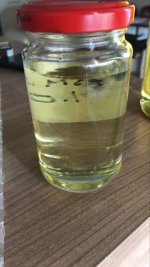- Language
- 🇬🇧
- Joined
- Jan 1, 2023
- Messages
- 64
- Reaction score
- 79
- Points
- 18
Now a run with the input from @Acab1312 (all credit goes to him) was carried out and the results were quite decent.
2000ml 85% phosporic acid were heated to about 65°C.1500g BMK 5449-12 were added in small portions and stirring. The reaction mixture was heated to 135°C and refluxed for 4 hours.
The layers were separated and the aqueous/phosporic acid layer extracted with DCM. (funny to see that the DCM layer is above, due to the high density of phosporic acid). The combined extracts were washed with water, brine and saturated bicarb solution to get the pH to neutral.
After drying over anhydrous sodium sulfate, the solvent was evaporated under regular pressure.
818 ml (813g) golden brown crude P2P was obtained. Yield : 80,93%

The crude P2P was distilled under reduced pressure to give 656ml (652g) pale yellow, pure 1-phenyl 2-propanone aka P2P, phenylacetone. Yield: 64,90%

The lovely flowery smell of pure P2P is just marvelous.
2000ml 85% phosporic acid were heated to about 65°C.1500g BMK 5449-12 were added in small portions and stirring. The reaction mixture was heated to 135°C and refluxed for 4 hours.
The layers were separated and the aqueous/phosporic acid layer extracted with DCM. (funny to see that the DCM layer is above, due to the high density of phosporic acid). The combined extracts were washed with water, brine and saturated bicarb solution to get the pH to neutral.
After drying over anhydrous sodium sulfate, the solvent was evaporated under regular pressure.
818 ml (813g) golden brown crude P2P was obtained. Yield : 80,93%
The crude P2P was distilled under reduced pressure to give 656ml (652g) pale yellow, pure 1-phenyl 2-propanone aka P2P, phenylacetone. Yield: 64,90%
The lovely flowery smell of pure P2P is just marvelous.


